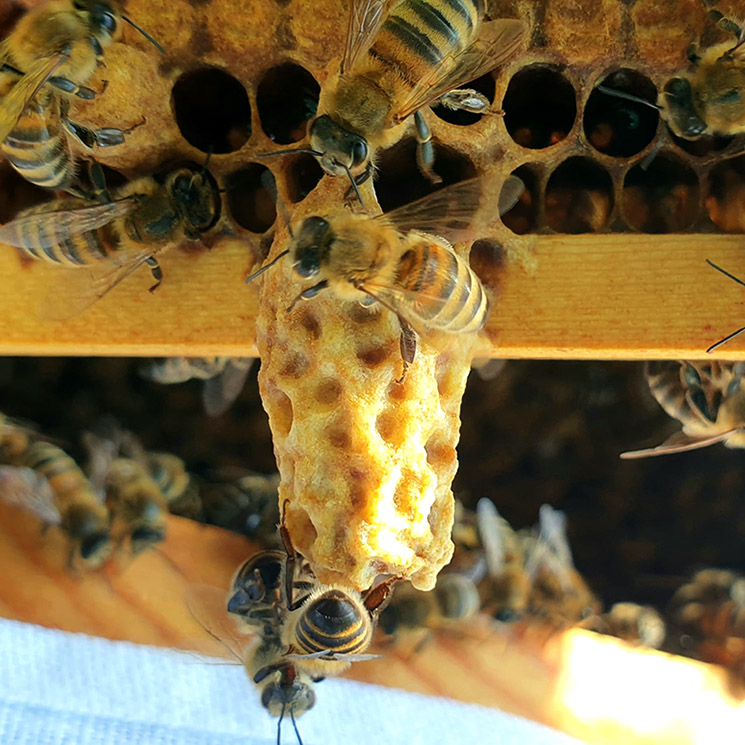Springtime for the Vicarage Honey Bees



While it is natural to sigh with relief when winter finally ebbs away, spring is one of the hardest times for both bees and beekeepers. This year’s unpredictable and erratic weather patterns were particularly challenging for our Sage and Alma colonies in the vicarage garden.
Throughout the winter the colonies remained in tight clusters, maintaining the core temperature at around 32°C. With the warm February weather, the clusters loosened up and spread out, the queens returned to laying, and the workers had to work even harder to generate enough heat to keep the brood nest warm. The stores of precious pollen and honey they gathered so diligently during the summer and autumn months were rapidly depleting. As these old winter bees died off, and the ever-increasing brood numbers began to outstrip the number of carers, housekeepers, and foragers, our Sage and Alma colonies risked starvation. We helped sustain them by supplementing their feeding with solid sugar fondant, syrup, and pollen patties. They seemed very pleased with the handouts.
The brief window of warm weather at the end of March, after a cold and wet month, was a boon, and we welcomed the opportunity to carry out the first hive inspection of the year. After leaving them largely undisturbed for five months, we faced that first peek inside with great excitement, but also some trepidation. We were encouraged to note that both queens were laying- we saw eggs, brood cells and young bees, and they were just beginning to build up new stores of honey and pollen. But Sage was clearly the stronger of the two colonies with many more brood cells in all stages of development, and many young bees. We sensed the Alma queen was struggling, so we decided to even out the populations by stealing a frame of capped brood from Sage and giving it to Alma to adopt as their own. It seemed to work, and the smaller colony began to grow and thrive.
We were surprised that after several inspections we failed to find our Alma queen -marked with a blue dot to make her easier to spot. We did eventually find another queen (unmarked), indicating that at some point the colony decided to supersede her. This can happen when the queen is ageing or ill, has run out of genetic material needed to fertilize her eggs, or has died. To keep up the colony numbers, the bees produce a new queen to take over the responsibility of laying eggs. This new Alma queen seemed to be a strong replacement, and by mid April both colonies were flourishing.
Sage, in fact, was so successful that conditions in the hive were starting to get crowded. Although we had provided them with extra space to store their honey, it clearly wasn’t enough. The workers were preparing new Queen cells, not to replace their fertile monarch, but in order to establish a second colony. She and about half of the bees were preparing to leave their former nest to find new lodgings. This swarming process is a perfectly natural and healthy activity in the life of a colony, but in urban settings it is not encouraged. We intervened by creating what’s known as an ‘artificial swarm’- removing our lovely Sage Queen, enough worker bees to support her, and several frames of brood and honey to a Nuc (a temporary hive). We then selected the healthiest looking Queen Cell back in the original hive, and destroyed all the others. This way our old Sage Queen was able to continue laying in her new space, while a new queen could take over in the old, much less crowded hive. We are now having new issues with both queens, but that’s a story for another time…we are still waiting to see how the it all plays out,
It has certainly been an eventful time and a steep learning curve for all of us. These mysterious and highly sophisticated insects are creatures of continuous wonderment. The more time I spend with them, the less knowledgeable I feel about their curious workings, but I remain in complete and utter awe.
(In the three photos below one is of our Sage Queen (marked blue); one of a well-developed Queen Cell ready to hatch; and one of a healthy frame showing the classic pattern of stored honey and pollen around the top, and big patches of brood- older and younger, sealed and unsealed.)